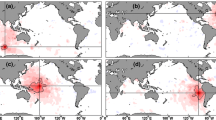Abstract
In the Ensemble Kalman Filter (EnKF) data assimilation-prediction system, most of the computation time is spent on the prediction runs of ensemble members. A limited or small ensemble size does reduce the computational cost, but an excessively small ensemble size usually leads to filter divergence, especially when there are model errors. In order to improve the efficiency of the EnKF data assimilation-prediction system and prevent it against filter divergence, a time-expanded sampling approach for EnKF based on the WRF (Weather Research and Forecasting) model is used to assimilate simulated sounding data. The approach samples a series of perturbed state vectors from N b member prediction runs not only at the analysis time (as the conventional approach does) but also at equally separated time levels (time interval is Δt) before and after the analysis time with M times. All the above sampled state vectors are used to construct the ensemble and compute the background covariance for the analysis, so the ensemble size is increased from N b to N b+2M×N b=(1+2M)×N b) without increasing the number of prediction runs (it is still N b). This reduces the computational cost. A series of experiments are conducted to investigate the impact of Δt (the time interval of time-expanded sampling) and M (the maximum sampling times) on the analysis. The results show that if Δt and M are properly selected, the time-expanded sampling approach achieves the similar effect to that from the conventional approach with an ensemble size of (1+2M)×N b, but the number of prediction runs is greatly reduced.
Similar content being viewed by others
References
Anderson, J. L., 2001: An ensemble adjustment Kalman filter for data assimilation. Mon. Wea. Rev., 129, 2884–2903.
—, and S. L. Anderson, 1999: A Monte Carlo implementation of the nonlinear filtering problem to produce ensemble assimilations and forecasts. Mon. Wea. Rev., 127, 2741–2758.
Caya, A., J. Sun, and C. Snyder, 2005: A comparison between the 4D-Var and the ensemble Kalman filter techniques for radar data assimilation. Mon. Wea. Rev., 133, 3081–3094.
Evensen, G., 1994: Sequential data assimilation with a nonlinear quasi-geostrophic model using Monte Carlo methods to forecast error statistics. J. Geophys. Res., 99, 10143–10162, doi:10.1029/94JC00572.
Gao, J., and M. Xue, 2008: An efficient dual-resolution approach for ensemble data assimilation and tests with assimilated Doppler radar data. Mon. Wea. Rev., 136, 945–963.
Gaspari, G., and S. E. Cohn, 1999: Construction of correlation functions in two and three dimensions. Quart. J. Roy. Meteor. Soc., 125, 723–757.
Gong Jiandong and Zhao Gang, 2006: Accurate estimation and application of 3-D error covariance structures in global data assimilation. Part II: Background error covariance structure adjustments and numerical experiments. Acta Meteor. Sinica, 64(6), 684–698. (in Chinese)
Hamill, T. M., J. S. Whitaker, and C. Snyder, 2001: Distance-dependent filtering of background error covariance estimates in an ensemble Kalman filter. Mon. Wea. Rev., 129, 2776–2790.
—, and C. Snyder, 2002a: A hybrid Ensemble Kalman Filter-3D variational analysis scheme. Mon. Wea. Rev., 128, 2905–2919.
—, and —, 2002b: Using improved background error covariances from an ensemble Kalman filter for adaptive observations. Mon. Wea. Rev., 130, 1552–1572.
Houtekamer, P. L., and H. L. Mitchell, 1998: Data assimilation using an ensemble Kalman filter technique. Mon. Wea. Rev., 126, 796–811.
—, and —, 2001: A sequential ensemble Kalman filter for atmospheric data assimilation. Mon. Wea. Rev., 129, 123–137.
Le Dimet, F.-X., and O. Talagrand, 1986: Variational algorithms for analysis and assimilation of meteorological observations: Theoretical aspects. Tellus, 38A, 97–110.
Lewis, J. M., and J. C. Derber, 1985: The use of adjoint equations to solve a variational adjustment problem with advective constraints. Tellus, 37A, 309–322.
Liang, A., Q. Zhang, Q. Liu, et al., 2009: The 3D-Var data assimilation experiments on a dense fog event over the central plain of China. Acta Meteor. Sinica, 23(1), 116–127.
Manobianco, J., and P. A. Nutter, 1999: Evaluation of the 29-km Eta model. Part II: Subjective verification over Floida. Wea. Forecasting, 14, 18–37.
Mass, C. F., D. Ovens, K. Westrick, and B. A. Colle, 2002: Does increasing horizontal resolution produce more skillful forecasts? Bull. Amer. Meteor. Soc., 83, 407–430.
Mitchell, H. L., and P. L. Houtekamer, 2000: An adaptive ensemble Kalman filter. Mon. Wea. Rev., 128, 416–433.
Talagrand, O., 1997: An introduction to estimation theory. J. Meteor. Soc. Japan (Special Issue), 75, 257–288.
Whitaker, J. S., and T. M. Hamill, 2002: Ensemble data assimilation without perturbed observations. Mon. Wea. Rev., 130, 1913–1924.
Xu, Q., L. Wei, H. Lu, et al., 2008: Time-expanded sampling for ensemble-based filters: Assimilation experiments with a shallow-water equation model. J. Geophys. Res., 113, D02114, doi:10.1029/2007JD008624.
Xu Xiaoyong, Zheng Guoguang, and Liu Liping, 2004: Dynamical and microphysical and microphysical retrieval from simulated Doppler radar observations using the 4DVAR assimilation technique. Acta Meteor. Sinica, 62(4), 410–422. (in Chinese)
Zhang Shuwen, W. Li, W. Zhang, et al., 2005: Estimating the soil moisture profile by assimilating nearsurface observations with the Ensemble Kalman Filter (EnKF). Adv. Atmos, Sci., 22(6), 936–945.
Author information
Authors and Affiliations
Corresponding author
Additional information
Supported by the National Natural Science Foundation of China (40805044), Natural Science Foundation of Gansu Province (1010RJZA118), and Fundmental Research Fund for Central Universities Science and Technology Development Program of China (lzujbky-2010-12).
Chinese version to be published
Rights and permissions
About this article
Cite this article
Yang, Y., Gong, Z., Wang, J. et al. Time-expanded sampling approach for Ensemble Kalman Filter: Experiment assimilation of simulated soundings. Acta Meteorol Sin 25, 558–567 (2011). https://doi.org/10.1007/s13351-011-0502-0
Received:
Published:
Issue Date:
DOI: https://doi.org/10.1007/s13351-011-0502-0




